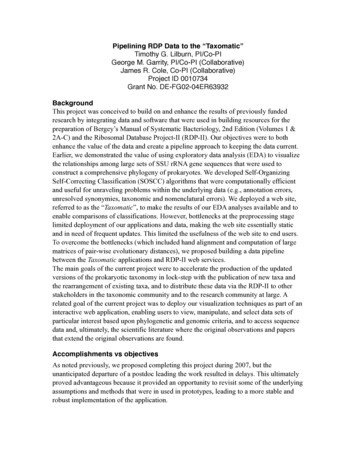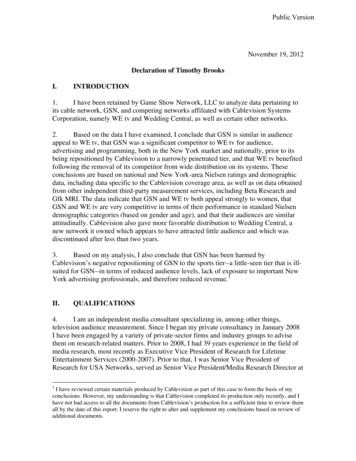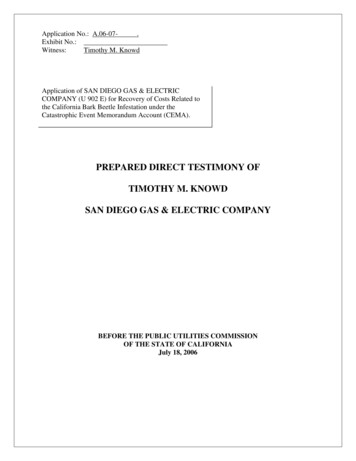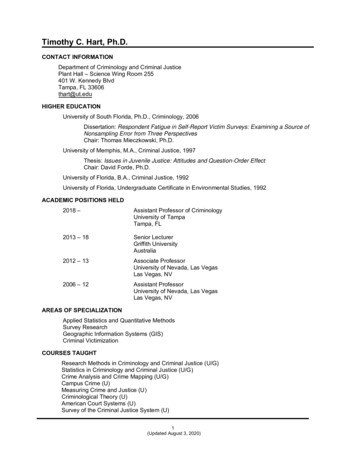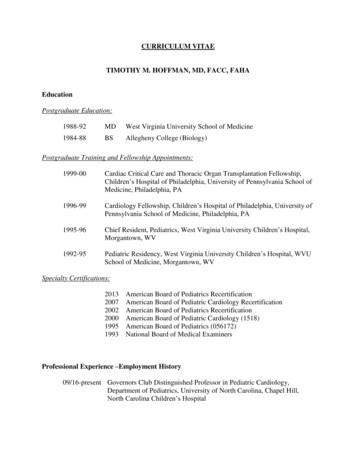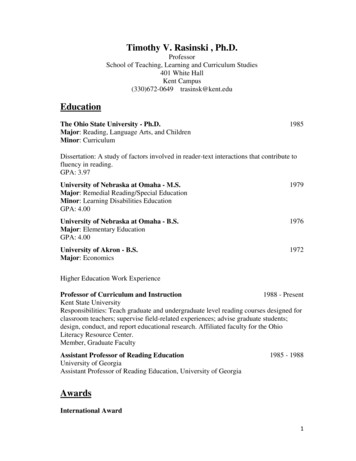
Transcription
Timothy T. SiminDepartment of FinanceSmeal School of BusinessThe Pennsylvania State University345 Business BuildingUniversity Park, PA 16802Homepage: http://timsimin.netOffice Phone: (814) 865-3457Home Phone: (814) 235-4858Fax: (814) 865-3362Education2002Ph.D. Finance, The University of Washington, Seattle, WashingtonMinors in Statistics and EconometricsDissertation: "The (Poor) Predictive Performance of Asset Pricing Models",Dissertation committee: Wayne Ferson (Chair), Alan Hess, Avi Kamara,Jennifer Koski, Doug Martin, Jeff Pontiff, and Eric Zivot1992Bachelor of Science in Economics and Finance with Honors, University ofTexas at Dallas. Graduated Summa Cum Laude, Thesis: "Budget Deficits,Interest Rates, and Capital Inflows"Academic Appointments2016-presentPhD Program Coordinator2008 - presentAssociate Professor, Smeal School of Business, The Pennsylvania StateUniversity2000 - 2008Assistant Professor, Smeal School of Business, The Pennsylvania StateUniversity2000Visiting Scholar at Kenan-Flagler Business School, University of NorthCarolina at Chapel Hill (MBA International Economics)Research:Empirical evaluation of the quality of the expectations generated by assetpricing models allowing for different degrees of time-variation in expectedreturns and risk premiums. Other interests include international finance androbust estimation techniques.
Teaching:Empirical Methods in Asset Pricing; (Ph.D.)Investments, Business Economics, International Economics, InternationalFinance; (Undergraduate, MBA and Executive MBA)Corporate Finance; (Undergraduate)Math Camp (Ph.D.)Journal Articles“Information Choice, Uncertainty, and Expected Returns”, with Charles Cao and DavidGempesaw, Review of Financial Studies (Forthcoming), 2020We investigate how information choices impact equity returns and risk. Building upon thetheory of Van Nieuwerburgh and Veldkamp (2010), we estimate a learning index that reflectsthe expected benefits of learning about an asset. High learning index stocks have lower futurereturns and risk compared to low learning index stocks. Analysis of a conditional asset pricingmodel, long run patterns in returns and volatilities, other measures of information ow, and theinformation environment surrounding earnings announcements reinforce our interpretation ofthe learning index. Our findings support the model's predictions and illustrate a novel empiricalmeasure of investor learning.“An Empirical Analysis of Commodity Convenience Yields”, with Cantekin Dincerler,Zeigham Khokher, Quarterly Journal of Finance, 2020, Vol. 10, No. 02, 2050009We study convenience yield dynamics using a dataset of inventories to proxy for relativescarcity. We confirm that convenience yields are negatively related to inventories although theyplateau during periods of scarcity for crude oil. Inventory withdrawals are non-monotonicallyrelated to the convenience yield and they forecast significant futures returns. Testing for theeffect of demand shocks, we document both temporary and permanent price components.Importantly, we show that mean reversion in expected equilibrium prices varies with relativescarcity. This result suggests an important bias in contingent claims models in extant practice.“Predicting the equity premium with the implied volatility spread”, withCharles Cao and Han Xiao, Journal of Financial Markets (lead article forthcoming), 2020 .We show that the call-put implied volatility spread (IVS) outperforms many well-knownpredictors of the equity premium at return horizons up to 6-months. The predictive ability of theIVS is unrelated to the dividend yield and is useful in explaining the cross-section of returns.Decomposing the IVS, we find the longer run predictive ability of the IVS operates primarilythrough a cash flow channel. We also find the IVS is significantly related to indicators ofaggregate market direction and expected market conditions. Our results are consistent with theIVS reflecting market sentiment as well as information about informed trading.
“The Decline of Informed Trading in the Equity and Options Markets”, with Charles Caoand David Gempesaw, Journal of Alternative Investments, 2018, 21 (20), Pages 16-29.Reliable excess returns from active portfolio management derive from informed trading. Weinvestigate the information content of informed trading in the equity market and the optionsmarket. We find that informed equity trading and options trading are positively correlated in thetime-series, but virtually uncorrelated cross-sectionally. Portfolio-level and stock-level analysesprovide robust evidence that the cross-sectional return predictive power of informed trading ineach market is distinct. Time-series analyses indicate that aggregate informed options tradingis useful for predicting market returns, but that the amount of informed trading has declinedsignificantly over the last 15 years. The time-series patterns of both our informed tradingmeasures coincide closely with the decline in equity hedge fund excess returns.“The Information Content of a Nonlinear Macro-Finance Model for Commodity Prices”,with Saqib Khan Zeigham Khokher. The Review of Financial Studies, 2017, 30(8), Pages2818–2850,State-of-the-art term structure models of commodity prices have serious difficultiesextrapolating the prices of long-maturity futures contracts from short-dated contracts. Thissituation is problematic for valuing real commodity-linked assets. We estimate a nonlinear fourfactor continuous time model of commodity price dynamics. The model nests many previousspecifications. To estimate the model, we use crude oil prices and inventories. The inventorydata and nonlinear price dynamics have a large impact on oil price forecasts. The additionalfactor in our model compared with current three-factor models has a significant impact onmodel-implied long-maturity futures prices.“Bringing Leased Assets onto the Balance Sheet”, with Kimberly Cornaggia and LaurelFranzen. Journal of Corporate Finance, 2013, Volume 22, Pages 345-360Pending changes in lease accounting standards will require firms to recognize obligations thathave historically been kept off- balance-sheet (OBS). We examine the implications of thisaccounting treatment for a host of common risk and performance metrics. Conventionalleverage, Z-Score, levered beta, return on capital and other asset utilization measuresunderestimate risk and overstate performance of firms relying heavily on OBS leasing. Thedistortion affects relative rankings as well as average levels and has increased over time.Proposed changes in reporting standards aim to mitigate future distortion, but necessitateadjustments for time-series comparisons. Under current reporting standards, investors, analysts,and researchers can estimate leased asset value and adjust accounting-based metrics to betterreflect these fixed costs.
“Do Mutual Fund Managers Time Market Liquidity?” with Charles Cao (the PennsylvaniaState University) and Ying Wang (State University of New York, Albany), Journal of FinancialMarkets, 2013, Volume 16, Issue 2, Pages 279-307.This paper examines mutual fund managers’ ability to time market-wide liquidity. Using theCRSP mutual fund database, we find strong evidence that over the 1974–2009 period, mutualfund managers demonstrate the ability to time market liquidity at both the portfolio level andthe individual fund level. Liquidity timing predicts future fund performance and the differencein the risk-adjusted returns between top and bottom liquidity-timing funds is approximately 2%per year. Funds exhibiting liquidity-timing ability tend to have longer histories, higher expenseratios, and higher turnover rates.“Do Growth Options Explain the Trend in Firm Specific Risk?” with Charles Cao (thePennsylvania State University) and Jing Zhao (North Carolina State University), Review ofFinancial Studies, 2008, 21(6), pp. 2599-2634.Winner of the Third NTU International Conference on Economics, Finance, and Accounting(IEFA) best paper award (2005).Campbell, Lettau, Malkiel, and Xu (2001) document increasing idiosyncratic volatility over thepast four decades. The explanation for this upward trend remains an open question. Motivatedby the classic corporate finance theory of Galai and Masulis, we provide a theoretic basedexplanation and show that the level and variance of corporate growth options, conditional onthe market value of capital structure, are significantly related to idiosyncratic volatility. Theseresults are robust across different exchanges and not due to the ‘internet bubble’ period. Theevidence clearly supports growth options over alternative explanations of the trend inidiosyncratic volatility.“Asset Pricing Regressions with Interaction Terms”, with Wayne E. Ferson (Boston College)and Sergei Sarkissian (McGill University), Journal of Financial and Quantitative Analysis,2008, 43(2), 331-354.This paper studies regression models in which lagged variables predict stock returns ininteraction with contemporaneous values of asset pricing factors. We concentrate on theirsampling properties in the presence of data mining and potential spurious regression due topersistent lagged regressors. We find that regressions with interaction terms remain reasonablywell specified for conditional betas, even in settings where simpler predictive regressions areseverely biased. This partially justifies the use of such regressions in recent asset pricing studies.
“The (Poor) Predictive Performance of Asset Pricing Models”, Journal of Financial andQuantitative Analysis, 2008, 43(2), 355-380.This paper examines forecast errors of conditional and unconditional asset pricing models forportfolio and firm level equity returns. A new result concerning model specification andforecasting that increases predictive precision is introduced. Conditional versions of the modelsgenerally produce lower mean squared errors than unconditional versions for in-sample but notfor step-ahead prediction. This hold true for individual firm data when the instruments are firmspecific. While decomposing the forecast error into separate variance and bias componentsindicates the models produce relatively unbiased predictions, one step ahead predictive abilityrarely exceeds that of simple benchmarks.“Measuring Distress Risk: The Effect of R&D Intensity”, with Laurel Franzen (Universityof Texas) and Kimberly J. Rodgers (New York University), Journal of Finance, 2007, 62(6),pp. 2391-2968.Because of upward trends in research and development activity, accounting measures offinancial distress have become less accurate. We document that (1) higher research anddevelopment spending increases the likelihood of misclassifying solvent firms, (2) adjusting forconservative accounting of research and development increases the number of correctlyidentified distressed firms, and (3) adjusted measures of distress alleviate previouslydocumented anomalously low returns of large high distress risk, low book-to-market firms. Theresults hold after updating stale parameters and under various tax assumptions. Our evidenceraises concerns about interpretation of extant literature that relies on accounting measures ofdistress.“Can Event Study Methods Solve the Currency Exposure Puzzle?” with Kathryn L.Dewenter and Robert C. Higgins (both from the University of Washington). Pacific-BasinFinance Journal, 2005, 13(2), pp. 119-144.Prior empirical evidence on the stock price response of exposed firms to contemporaneouschanges in exchange rates is weak. This paper avoids problems encountered in previous workby using event-study methods to examine the daily stock price reactions of exposed U.S.multinationals to large, bi-lateral declines in the Mexican peso and Thai baht. We find acontemporaneous price response but interpret the magnitude of the response to say that thecurrency puzzle is not primarily due to methodological weaknesses. Several findings suggestthat effective financial and operational hedging may be the chief reason exchange rate changesdo not affect stock prices more dramatically.“Is Stock Return Predictability Spurious?” with Wayne Ferson (Boston College) and SergeiSarkissian (McGill University). Journal of Investment Management, 2003, 1(3), pp. 1–10.Two problems, spurious regression bias and naïve data mining, conspire to mislead analystsabout predictive models for stock returns. This article demonstrates the two problems, how theyinteract, and makes suggestions for what to do about it.
“Spurious Regressions in Financial Economics?”* with Wayne Ferson (Boston College) andSergei Sarkissian (McGill University). Journal of Finance, 2003, 58(4), pp. 1393-1413.[nominated for the 2003 Smith-Breeden Award]Even though stock returns are not highly autocorrelated, there is a spurious regression bias inpredictive regressions for stock returns related to the classic studies of Yule (1926) and Grangerand Newbold (1974). Data mining for predictor variables interacts with spurious regressionbias. The two effects reinforce each other, because more highly persistent series are more likelyto be found significant in the search for predictor variables. Our simulations suggest that manyof the regressions in the literature, based on individual predictor variables, may be spurious.“Outlier Resistant Estimates of Beta” with R. D. Martin (University of Washington - Dept.of Statistics). Financial Analysts Journal, 2003, 59(5), pp. 56-69.Depending on location, outliers in returns can substantially bias ordinary least squares (OLS)estimates of beta. We introduce a new beta that is resistant to outliers causing the most bias inOLS estimates, but produces estimates similar to OLS for outlier free data. The beta is anintuitively appealing weighted least squares estimate with data-dependent weights. We contendthat the resistant beta provides a better predictor of future risk and return characteristics than theOLS beta in the presence of outliers and is a valuable complement to OLS beta. Our analysisreveals small firm betas are most susceptible to outliers.“The Alpha Factor Asset Pricing Model: A Parable” with Wayne Ferson (Boston College)and Sergei Sarkissian (McGill University). Journal of Financial Markets, 1999 2(1), pp. 4968. Abstracted in The CFA Digest 30(2), Spring 2000, pp. 17-18.Recent empirical studies use the returns of attribute-sorted portfolios of common stocks as ifthey represent risk factors in an asset-pricing model. If the attributes are chosen following anempirically observed relation to the cross-section of stock returns, such portfolios will appearto be useful risk factors, even when the attributes are completely unrelated to risk. We illustratethis result using a parable and argue that the moral of the story is important in practice.“The Market Reaction to Federal Reserve Policy Action from 1989 to 1992” with VincentReinhart (Board of Governors of the Federal Reserve System). Journal of Economics andBusiness, 1997, 49, pp. 149-168.An examination of the market reaction to Federal Reserve policy easings from 1989 to 1992suggests that these actions were mostly unexpected and were not viewed to be persistent.Changes in the intended trading range for the federal funds rate had their greatest impact on thenear-term outlook, but those effects diminished as the investing horizon lengthened. By thisinterpretation, any change in longer-term interest rates was mostly owed to the consequences oflower near-term rates, not to any substantial revision to the longer-run outlook. Mostsignificantly, the range of reaction was remarkably wide across all markets.
Book Chapters“Spurious Regression and Data Mining in Conditional Asset Pricing Models,” with (WayneFerson and Sergei Sarkissian), Handbook of Quantitative Finance,3(1), C.F. Lee, Editor,Springer Publishing“Estimating the exchange rate exposure of US multinational firms: Evidence from anevent study methodology,” (with Kathryn L. Dewenter and Robert C. Higgins), in RiskManagement, eds. Michael Frenkel, Ulrich Hommel, Markus Rudolf, Springer, 2000.“Robust Beta Mining,” (with R. D. Martin), in Information Visualization in Data Mining andKnowledge Discovery," ed. U. Fayyad, G. Grinstein, and A. Wierse, 2001.Working Papers“Does Capital Gains Taxation Impact Asset Prices?”, 2018, with Stephen Lenkey.“Betting Against Leverage”, 2017, Kimberly Cornaggia and Fatma Sonmez“Return Predictability under the Alternative”, 2013 with Marco Rossi (University of NotreDame) and Daniel R. Smith (Queensland University of Technology - School of Economicsand Finance). [TOP 10 Papers for Journal of ERN: Hypothesis Testing (Topic) January14, 2013 to March 15, 2013]Technical Reports“Robust Estimation of Beta” with Douglas R. Martin (University of Washington).University of Washington Statistics Department Tech. Report no. 350, 1999“Estimates of Small-Stock Betas are Often Very Distorted by Outliers,” with Douglas R.Martin (University of Washington). University of Washington Statistics Department Tech.Report no. 351, 1999Professional ActivitiesEditorial ServicesAssociate Editor: Review of Quantitative Finance and AccountingAssociate Editor: Quantitative Finance Letters,Associate Editor (Finance) for Canadian Journal of Administrative Sciences
Conference Presentations/Discussions/Session ChairWestern Finance Association (1998, 2000, 2002, 2003, 2004, 2005), FinancialManagement Association Doctoral Student Consortium (1999), FinancialManagement Association (2000, 2002, 2004, 2005, 2007), Northern FinanceAssociation (2000, 2001, 2002, 2003, 2004, 2005, 2006, 2007, 2008, 2009,2010, 2011, 2012, 2013, 2014, 2015, 2016), European Finance Association(2004), Conference on Financial Economics and Accounting (2006), AmericanFinance Association (2007), Sanford-Bernstein: Controversies in QuantitativeFinance and Asset Mgt. (2007, 2008, 2009, 2010), Theory and Practices ofSecurities and Financial Markets Conference (2005), SFS Cavalcade (2012),Queens School of Business Behavior Finance Conference (2011, 2012), PSUCMU-PITT Conference (2017, 2018)Referee ServicesAnnals of Finance, Contemporary Accounting Review, Energy Economics,Finance Research Letters, Financial Management, Financial Review, Journal ofAsia-Pacific Business, Journal of Banking and Finance, Journal of Businessand Economic Statistics, Journal of Economics and Business, Journal ofEmpirical Finance, Journal of Finance, Journal of Financial and QuantitativeAnalysis, Journal of Financial Econometrics, Journal of Financial Research,Journal of Futures Markets, Journal of International Money and Finance,Journal of Risk, Journal of Undergraduate Research in Finance, ManagementScience, Pacific Basin Finance Journal, Quantitative Finance, QuarterlyReview of Economics and Finance, Research Grants Council of Hong Kong,Review of Asset Pricing Studies, Review of Economic Studies, Review ofFinance, Review of Financial Studies, Southern Economic Journal, TheAccounting Review, The Journal of Undergraduate Research in Finance, TheQuarterly Journal of Finance and Accounting, The Southern Economic Journal
Research WorkshopsUniversity of Washington (1998, 1999, 2002), University of North Carolina atChapel Hill (1999), Arizona State University (2000), Pennsylvania StateUniversity (2000, 2001, 2004), Syracuse University (2000), Southern MethodistUniversity (2000), Texas A&M (2000), University of Western Ontario (2004,2008), University of Texas at Dallas (2004), HEC Montreal (2005), Universityof Toronto (2006), Bank of Canada (2006), Queens University (2006),University of Amsterdam (2006), Norwegian School of Management (2006),University of Copenhagen (2006), Temple University (2006, 2007), IndianaUniversity (2008), Baruch University (2008), North Carolina State University(2008), American University (2008), Binghamton University (2009), Universityof Texas at Austin (2009), University of Texas at San Antonio (2011), LavalUniversity (2011), University of North Carolina (2012), University of Missouri(2012
2000 - 2008 Assistant Professor, Smeal School of Business, The Pennsylvania State University 2000 Visiting Scholar at Kenan-Flagler Business School, University of North Carolina at Chapel Hill (MBA International Economics) Research: Empirical evaluation of the quality of the expectations generated by asset .
